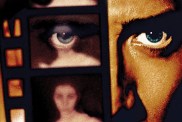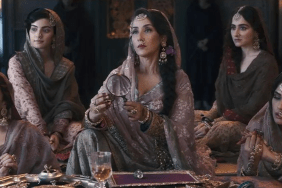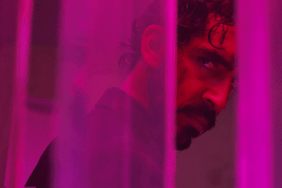
Ang Lee‘s Life of Pi, based on Yann Martel’s Booker Prize-winning novel of the same name, is first and foremost a spiritual journey for its title character. A God-loving zookeeper’s son, Pi (Suraj Sharma) is emigrating with his family from India to North America aboard a Japanese cargo ship with the animals stored below when a violent storm sends the ship to the bottom of the ocean. Pi survives aboard a lifeboat, which he shares with a hyena, a zebra, an orangutan and a massive Bengal tiger named Richard Parker. What follows is Pi’s story of enlightenment and survival.
Like the book, the film is told as a flashback with a twenty-years older Pi (Irrfan Khan) relaying his story to an author (Rafe Spall) that has been told Pi had a story that would make him believe in God.
God, in this instance, should most likely be placed in quotes because for Pi there is no definitive version as he chooses to practice not only his native Hinduism, but Christianity and Islam as well. He’s a lover of stories and he’s a boy of feelings and his belief in God is one that can’t very well be confined to one religion.
So, what exactly does it mean this story will make us believe in God?
I took it as a reference to an idea, a feeling and a presence more than any one, singularly specific all-powerful being, though even that could be up for debate. This “idea” also manifests itself as a preference and a choice, which comes to light as the story moves into its third act, asking what you choose, or prefer, to believe when faced with the harshness of reality when questioning the unbelievable.
In this sense, Life of Pi is really all about what you make it. It’s a film that will probably move some people to tears while others may be left stone-faced and unmoved. I fall somewhere in-between.
I marveled at Ang Lee’s visuals as this is a film that wouldn’t be nearly as effective had Lee and cinematographer Claudio Miranda not composed their shots in such a painterly fashion. It’s simply beautiful and some shots will leave you breathless as Mychael Danna‘s score swells and the waves come crashing down.
You become absorbed in the story, which can also be attributed to this being the first time I’ve seen a non-IMAX 3-D film and can say the use of 3-D actually has an impact on the story. The majority of stereoscopic films add depth to an image without inviting the viewer in, whereas Life of Pi brings the story to you.
I attribute much of this to the barren, watery landscape of much of the picture. The 3-D, in fact, can sometimes be attributed to giving life to a story where it tends to drag. The film opens with Pi at home in India, dabbling in a variety of religions and introducing us to his family. The majority of the rest of the story is set at sea with Pi and Richard Parker fighting to survive amid powerful storms, flying fish and whales in a sea of jellyfish illuminated by the moonlight. It’s a breathtaking picture in large part, but I can’t say I walked away as moved as I felt I was intended to be.
The message that comes across in the end is one to take note of, but I can’t say I’ve found myself dwelling on it since leaving the theater. For me, Life of Pi is more of a uniquely composed vision that’s a bit more meditative than I felt was necessary. It dwells far too long on Pi’s plight at sea, running almost 10-15 minutes too long with an island sequence in particular marking the moment it began to lose my attention, largely because I felt it had reached its emotional climax only minutes earlier.
All of that said, it all really comes down to one word for me, and if you haven’t read the book or seen the movie you may want to stop here and read the final paragraphs after you’ve seen it.
Upon surviving the ordeal Pi is asked by two members of the Japanese Ministry of Transport to tell the story of what happened to the ship that sank. Pi tells them the story as seen in the film, which they don’t accept and ask him to tell them a story they can believe. So he tells them a story where the animal inhabitants in the original story are now people that were aboard the ship, including the ship’s ill-tempered cook (Gerard Depardieu) and Pi’s mother. The horrific story involves murder and cannibalism. It’s a story where all hope is lost and the question of “What is the point of surviving if this is the world we live in?” becomes entirely valid.
After telling the story we flash back to the present where the older Pi asks the author interviewing him, “What story do you prefer?” The author replies, “The one with the tiger.”
The phrasing of the question immediately struck me. The word “prefer” I found to be an odd choice. Why not ask, “What story do you believe?” or even “What story do you prefer to believe?”
In short, to prefer the story with the tiger is to prefer Pi’s family died in a watery grave and the murderous and ugly side of human nature was never given the chance to show its face, substituted with the will to survive in the face of the most extreme conditions.
To prefer the gruesome story of murder and cannibalism is to say all you can really understand and accept as reality in this world is the ugly side of humanity.
So which story do you prefer? Well obviously the story with the tiger, but with that answer comes some serious repercussions, especially if you rephrase the question to ask which story you believe.
You can prefer a story that sounds too good to be true because it is more appealing than the actual truth, but can you believe it? Whether it’s murder and cannibalism or a tiger killing a goat as its next meal, we would prefer softer more delicate realities, but are they believable? As evidenced in this story all harsh realities are softened throughout Pi’s journey. The moment Richard Parker kills a goat isn’t shown, the story of what may or may not have happened aboard that lifeboat is harsh to a point, but any and all death is never seen on screen. Are we really meant to turn our attention away from reality so as to create the illusion that the world is a better place than it actually may be?
With that I will say I believe the horror story Pi tells second to be the true story, but not because the story with the tiger is so unbelievable, but because the second story is told with such immediacy, emotion and description. You may say, “But so was the story of the tiger,” to which I would say, “Yes, the mind can come up with some pretty impressive hallucinations when facing such a traumatic experience. Not to forget, Pi’s asking what story you ‘prefer’ is a big wink in my opinion.”
I love it when films leave things open for interpretation and discussion and that’s where Life of Pi earns my respect beyond its tremendous visuals, but in the end Pi doesn’t ask which story we prefer by accident. The word “prefer” is intentional and as a result I felt it throws a wrench in everything it aimed to accomplish.
Visually it’s a masterpiece, but when it comes to looking at it on a deeper level I found too many things caused it to unravel.









